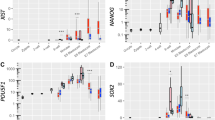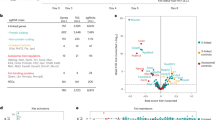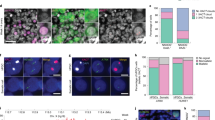Abstract
Only one of the two X chromosomes is active in each somatic cell of adult female eutherian mammals, making the females (XX) equivalent to the males (XY) with respect to X chromosome dosage1–4. Biochemical analyses showing that both X chromosomes are active in female mouse embryos in midcleavage stage4–8 indicate that X chromosome differentiation involves inactivation. This event occurs in most or all cells of the embryo at the blastocyst stage4,7–9, when there are two cell types, the outer sphere of trophectoderm cells and the inner cell mass (ICM). Because there is genetic evidence that both X chromosomes are potentially active in ICM cells10, it has been suggested that X chromosome inactivation has occurred in only the trophectoderm cells9. Further, one of us (M.M.)4 has proposed that X chromosome differentiation is linked to cellular differentiation, occurring at different times in different cell populations as they ‘depart’ or terminally differentiate from a pluripotent fetal ‘stem line’ (Fig. 1). Analysis of a large number of inner cell masses isolated immunosurgically from female blastocysts has yielded data consistent with the presence of two active X chromosomes11, but ICMs are so small that the biochemical assay used was at the limit of its accuracy. (Nevertheless, a computer analysis of the data8 indicated two ICM populations differing twofold with respect to X chromosome activity.) More tissue is available for analysis in post-implantation embryos, in which, on the above hypothesis, we would expect two active X chromosomes in the pluripotent epiblast region before gastrulation, but only one in the corresponding extra-embryonic ectoderm (a trophectoderm-derived tissue12) and primary endoderm (ICM-derived12, see Fig. 1). We report here that this is the case; we also show that inactivation is complete in the epiblast (fetal precursor) cells between 6.0 and 6.5 d of gestation at the onset of gastrulation.
This is a preview of subscription content, access via your institution
Access options
Subscribe to this journal
Receive 51 print issues and online access
$199.00 per year
only $3.90 per issue
Buy this article
- Purchase on Springer Link
- Instant access to full article PDF
Prices may be subject to local taxes which are calculated during checkout
Similar content being viewed by others
References
Lyon, M. F. A. Rev. Genet. 2, 31–52 (1968); Biol Rev. 47, 1–35 (1972); Proc. R. Soc. B187, 243–268 (1974).
Eicher, E. M. Adv. Genet. 15, 175–259 (1970).
Gartler, S. M. & Andina, R. J. Adv. hum. Genet. 7, 99–140 (1976).
Monk, M. in Development in Mammals Vol. 3 (ed. Johnson, M. H.) (North-Holland, Amsterdam, 1978).
Adler, D. A., West, J. D. & Chapman, V. M. Nature 267, 838–839 (1977).
Monk, M. & Harper, M. J. Embryol. exp. Morph. 46, 53–64 (1978).
Epstein, C. J., Smith, S., Travis, B. & Tucker, G. Nature 274, 500–502 (1978).
Kratzer, P. G. & Gartier, S. M. Nature 274, 503–504 (1978).
Monk, M. & Kathuria, H. Nature 270, 599–601 (1977).
Gardner, R. L. & Lyon, M. Nature 231, 385–386 (1971).
Monk, M. in Proc. Conf. Genetic Mosaics and Chimeras in Mammals (ed. Russell, L.) (Oak Ridge National Laboratory, 1978).
Gardner, R. L. & Papaioannou, V. E. in 2nd Symp. Br. Soc. dev. Biol. (Cambridge University Press, 1975).
Kozak, C., Nichols, E. & Ruddle, F. H. Somat. Cell Genet. 1, 371–382 (1975).
Snow, M. H. L. J. Embryol. exp. Morph. 42, 293–303 (1977).
Kozak, L. P. & Quinn, P. J. Devl Biol. 45, 65–73 (1975).
Takagi, N. & Sasaki, M. Nature 256, 640–642 (1975).
Wake, N., Takagi, N. & Sasaki, M. Nature 262, 580–581 (1976).
West, J. D., Frels, W. I., Chapman, V. M. & Papaioannou, V. E. Cell 12, 873–882 (1977).
Ohno, S. A. Rev. Genet. 3, 495–524 (1969).
Kahan, B. & De Mars, R. Proc. natn. Acad. Sci. U.S.A. 72, 1510–1514 (1975).
Comings, D. E. Nature 230, 292–294 (1966).
Migeon, B. R. Nature 239, 87–89 (1972).
Martin, G. R. et al. Nature 271, 329–333 (1978).
Whittingham, D. G. & Wales, R. G. Aust. J. biol. Sci. 22, 1065–1068 (1969).
Author information
Authors and Affiliations
Rights and permissions
About this article
Cite this article
Monk, M., Harper, M. Sequential X chromosome inactivation coupled with cellular differentiation in early mouse embryos. Nature 281, 311–313 (1979). https://doi.org/10.1038/281311a0
Received:
Accepted:
Issue Date:
DOI: https://doi.org/10.1038/281311a0
This article is cited by
-
Derivation of healthy hepatocyte-like cells from a female patient with ornithine transcarbamylase deficiency through X-inactivation selection
Scientific Reports (2022)
-
No imprinted XIST expression in pigs: biallelic XIST expression in early embryos and random X inactivation in placentas
Cellular and Molecular Life Sciences (2019)
-
Female mice lacking Ftx lncRNA exhibit impaired X-chromosome inactivation and a microphthalmia-like phenotype
Nature Communications (2018)
-
PRC2 represses transcribed genes on the imprinted inactive X chromosome in mice
Genome Biology (2017)
-
A rapid passage through a two-active-X-chromosome state accompanies the switch of imprinted X-inactivation patterns in mouse trophoblast stem cells
Epigenetics & Chromatin (2015)
Comments
By submitting a comment you agree to abide by our Terms and Community Guidelines. If you find something abusive or that does not comply with our terms or guidelines please flag it as inappropriate.



